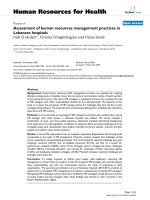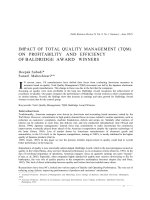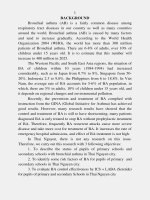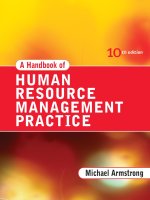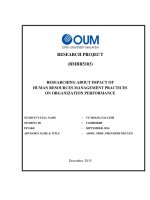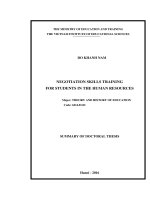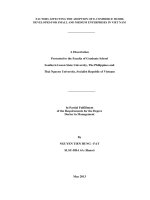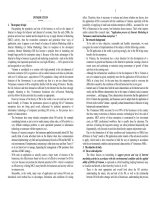Impact of human resource management practices on organizational performance in small and medium enterprises in thai nguyen city
Bạn đang xem bản rút gọn của tài liệu. Xem và tải ngay bản đầy đủ của tài liệu tại đây (1.12 MB, 136 trang )
IMPACT OF HUMAN RESOURCE MANAGEMENT PRACTICES ON
ORGANIZATIONAL PERFORMANCE IN SMALL AND
MEDIUM ENTERPRISES IN THAI NGUYEN CITY
___________________________
A DISSERTATION
Presented to the Faculty of the Graduate School
Southern Luzon State University, Lucban, Quezon, Philippines
in Collaboration with
Thai Nguyen University, Socialist Republic of Vietnam
___________________________
In Partial Fulfillment
of the Requirements for the Degree
Doctor of Business Administration
___________________________
By
LE KIM ANH (MAY)
December 2013
i
APPROVAL SHEET
The Dissertation of
LE KIM ANH
entitled
IMPACT OF HUMAN RESOURCE MANAGEMENT PRACTICES ON
ORGANIZATIONAL PERFORMANCE IN SMALL AND MEDIUM
ENTERPRISES IN THAI NGUYEN CITY, VIETNAM
Submitted in Partial Fulfilment of the Requirements for the Degree
DOCTOR OF BUSINESS ADMINISTRATION
A program offered by Southern Luzon State University,
Republic of the Philippines in collaboration with
Thai Nguyen University, Socialist Republic of Vietnam
has been approved by Oral Examination Committee
MELCHOR MELO O. PLACINO, PhD
Expert
WALBERTO A. MACARAAN, EdD
Expert
CONRADO L. ABRAHAM, PhD
Expert
EDWIN P. BERNAL, DBA
External Panel
CECILIA N. GASCON, PhD
Chairman
Endorsed by:
Recommended by:
ALICE T. VALERIO, PhD
Adviser
APOLONIA A. ESPINOSA, PhD
Dean
Accepted in Partial Fulfilment of the Requirements for the Degree
Doctor of Business Administration
_____________________
Date
WALBERTO A. MACARAAN, EdD
Vice President for Academic Affairs
ii
CERTIFICATE OF ORIGINALITY
This is to certify that the research work / dissertation entitled “Impact
of Human Resource Management Practices on the Organizational
Performance of the Small and Medium Enterprises in Thai Nguyen
Province”, orally defended/ presented under the DBA Program jointly offered
by Southern Luzon State University of the Republic of the Philippines and
Thai Nguyen University of the Socialist Republic of Vietnam, embodies the
result of original and scholarly work carried out by the undersigned.
This dissertation does not contain words or ideas taken from published
sources or written works by other persons which have been accepted as basis
for the award of any degree from other higher education institutions, except
where proper referencing and acknowledgement were made.
_____________________
Researcher/Candidate
Date Orally Defended:
__________________
iii
ACKNOWLEDGMENT
I would like to extend my sincerest gratitude and thanks to the following
people who made this piece of work a reality.
DR. Cecilia N. Gascon, President of the Southern Luzon State
University in the Republic of the Philippines, for her untiring effort and belief
that this collaboration is possible thus enabling us to pursue the DBA degree;
Dr. Dang Kim Vui President of Thai Nguyen University in the Socialist
Republic of Vietnam, for his untiring effort and belief that this collaboration is
possible thus enabling us to pursue the DBA degree;
Dr. Alice T. Valerio, for her support and supervision during my study;
her kindness and daily instructions in the last three years are highly
appreciated and this dissertation is as much her work as mine;
Prof. Nordelina Ilano, Director, Office for International Affairs for her
support to DBA1 students;
Dr. Tran Thanh Van, the Dean of Graduate School; Dr Dang Xuan
Binh, Director of International Training Center; and Dr Nguyen Thanh Hai,
Vice Director of International Training Center of Thai Nguyen University, for
their assistance and encouragement to pursue this study;
All the SLSU and TNU Professors, for their support and guidance
throughout the study in Thai Nguyen University, Vietnam;
My dearest friends for their kindness and remarkable support; and
My family, for their support and encouragement – my source of
greatest inspiration for my success;
Le Kim Anh
iv
DEDICATION
This research is wholeheartedly dedicated with all sincerity and love to
my FAMILY…..
To my Mom and my son who provided me with love and care.
To ALL OF THEM…I humbly dedicate my work and success in life.
Le Kim Anh
v
TABLE OF CONTENTS
PAGE
TITLE PAGE ………………………………………………………………..
i
APPROVAL SHEET ……………………………………………………….
ii
CERTIFICATE OF ORIGINALITY ………………………………………..
iii
ACKNOWLEDGEMENT …………………………………………………..
iv
DEDICATION ………………………………………………………………
vi
TABLE OF CONTENTS …………………………………………………..
vii
LIST OF TABLES ………………………………………………………….
ix
LIST OF FIGURES ………………………………………………………...
x
LIST OF APPENDICES …………………………………………………...
xi
ABSTRACT …………………………………………………………………
xiii
CHAPTER
I
II
III
IV
INTRODUCTION ……………………………………………
1
Background of the Study …………………………………..
3
Objectives of the Study …………………………………….
6
Hypotheses of the Study ………………………..…………
7
Significance of the Study …………………………………..
7
Scope and Limitations of the Study ………………………
8
Definition of Terms ………………………………………….
8
REVIEW OF LITERATURE ……………………………….
12
Conceptual Framework ………………………………….…
66
METHODOLOGY
Locale of the Study …………………………………………
69
Research Instrument ……………………………………….
69
Populations, Sample Size & Sampling Technique ……...
70
Data Gathering Procedure …………………………………
70
Statistical Treatment ………………………........…….……
71
RESULTS AND DISCUSSIONS ………………………….
74
vi
V
SUMMARY, FINDINGS, CONCLUSIONS AND
RECOMMENDATION
Summary…………….………………………………………
97
Conclusions …………………………………………………
101
Recommendations …………………………………………
102
REFERENCES ………………………...…………………………………..
107
APPENDICES ……………………………………………………………...
114
CURRICULUM VITAE …………………………………………………….
122
vii
LIST OF TABLES
TABLE
1
PAGE
Numerical and Adjectival Ratings for Organizational
Performance
71
Percentage Distribution of Respondents’ Profile in Terms
of Type of Industry and Ownership
75
Percentage Distribution of Respondents’ Profile in Terms of
Business Characteristics
76
The Assessment of Respondents on HRM in Terms of
Recruitment and Selection
77
The Assessment of Respondents on HRM in Terms of Training
and Development
78
The Assessment of Respondents on HRM in Terms of Career
Planning System
79
The Assessment of Respondents on HRM in Terms of Participation
and Involvement
80
The Assessment of Respondents on HRM in Terms of
Compensation and Benefits
81
The Assessment of Respondent on HRM in Terms of
Performance Appraisal
82
10
Perceived Organizational Performance
83
11
Variables Included in Analyses
85
12
Descriptive Statistics
86
13
Correlations amongst Variables
90
2
3
4
5
6
7
8
9
viii
LIST OF FIGURES
FIGURE
1
PAGE
The Category of Micro, Small and Medium-Sized
Enterprises
13
2
General Features of the SMEs Organization System
16
3
The Impact of the Factors of SMEs’s HR Practices on the
Organizational Performance
68
4
Distribution of Respondents’ Profile by Type of Industry
75
5
Distribution of Respondents’ Profile by Type of Ownership
76
ix
LIST OF APPENDICES
APPENDIX
PAGE
A
Letter to Respondents
115
B
Questionnaire - Checklist
116
`
x
ABSTRACT
Title of Research
: IMPACT OF HUMAN RESOURCE MANAGEMENT
PRACTICES ON ORGANIZATIONAL
PERFORMANCE IN SMALL ANDMEDIUM
ENTERPRISES IN THAI NGUYEN CITY
Researcher
: LE KIM ANH (MAY)
Degree Conferred
: DOCTOR OF BUSINESS ADMINISTRATION
Name and Address
of Institution
: Southern Luzon State University Lucban, Quezon,
Philippines and Thai Nguyen University, Socialist
Republic of Vietnam
Adviser
: Dr. Alice T. Valerio
Year Written
: 2013
______________________________________________________________
The study was conducted to assess impact of human resource
management practices on the organizational performance of the small and
medium enterprises in Thai Nguyen Province. A total of 290 managers of the
small and medium-sized enterprises in Thai Nguyen City was selected to be
the respondents of the study. It specifically explored on the profile of the
respondents in terms of types of enterprise; form of ownership; time of
operation; and number of employees. The study was limited to determine the
perception of the respondents on the human resource practices of the small
and medium enterprises in Thai Nguyen City which are classified in various
aspects, namely: Recruitment and Selection; Training and development;
Career planning System; Participation and Involvement; Compensation and
Benefit; and Performance appraisal.
The 290 selected respondents were asked to complete a self-designed
questionnaire after being explained and instructed by the researcher. The
xi
researcher floated the questionnaire to the respondents after it had been
validated by her advisor in June 2013.
Using standardized test, recruitment and selection, based on welldefined merit and unprejudiced system developed through managerial expert
opinions, to scrutinize the exact required attitude, skills and knowledge in
potential candidates showed notable significant correlation with employee
performance and perceived organizational performance which identifies the
right candidate with required skills to perform the job for achieving
organizational
performance.
Training
and
development
programs
in
organizations based on training need assessment, performance appraisal,
and customization and practically applicable with skills imparting capability are
indicating positive correlation with employee performance and perceived
organizational performance.
A perception that the Career Planning System (CPS) is significantly
correlated
with
employee
performance
and
perceived
organizational
Performance is true if the CPS is based on clear career ladder, aligned goals
with organizational vision, used for succession planning, transparent internal
hiring, and equal unambiguous employment opportunity.
Employee
participation related to decision-making process based on opportunities to
make company and self-related decisions, suggestion collection for the
betterment of organization and employee wellbeing as an appreciation
strategy have significant positive correlation with perceived organizational
performance.
xii
Compensation
system
based
on
expectancy
of
employees,
comparable with market packages, competency-based, performance-based,
profit sharing-based
dimensions
are
mechanism, covering both financial and non-financial
positively
correlated
with
perceived
organizational
performance.
There is a significant relationship between perceived organizational
performance and performance appraisal system, which are based on focused
counselling, employee feedback, transparent disbursement of bonuses,
performance-based promotions, training selections, and clarity of objectives.
xiii
Chapter I
INTRODUCTION
Human resource management (HRM) is the process of developing,
applying and evaluating policies, procedures, methods and programs relating
to the employment, motivation, maintenance, and management of people in
the organization. Human resource management includes activities like
strategic HRM, human capital management, corporate social responsibility,
human resource planning, recruitment, selection, training and development,
reward management, performance management, employee relations, health
safety and employee well-being as well as provision of employee services. It
comprises a set of practices and policies designed to maximize organizational
integration, employee commitment, flexibility, and quality of work (Armstrong,
2009).
Effective
human
resource
(HR)
practices
relate
to
company
performance by contributing to employee and customer satisfaction,
innovation, productivity, and development of a favorable reputation of the firm
in the industry. A number of researchers have reported that HR practices are
positively linked with organizational and employee performance.
Researchers have argued that human resources may be seen as a
source of sustained competitive advantage for organizations (Barney, 1991;
Becker & Gerhart, 1996). The underlying assumption is that human resources
are unique to the extent that competitors cannot imitate them. Research has
led to the identification of a number of HRMpractices that contribute to
company performance across different organizations (Huselid, 1995). In a
literature review, Delery and Doty (1996) identified seven such practices that
2
have been consistently considered HRM practices. They defined HRM
practices as those that are theoretically or empirically related to overall
organizational
performance.
opportunities,
formal
These
training
practices
systems,
include
internal
results-oriented
career
appraisals,
employment security, participation, job descriptions, and profit sharing. This
approach has come to be known as the “best practices” or universalistic
approach. Within the best practices approach to strategic HRM, the first
practice, internal career opportunities, refers to the organizational preference
for hiring primarily from within. Second, training systems refers to whether
organizationsprovide extensive training opportunities for their employees or
whether they depend on selection and socialization processes to obtain
required skills. Third, appraisals are conceptualized in terms of outcomebased performance ratings and the extent to which subordinate views are
taken into account in these ratings. Fourth, employment security reflects the
degree to which employees feel secure about continued employment in their
jobs. Although formalized employment security is generally on the decline,
organizations may have either an implicit or an explicit policy. Fifth, employee
participation, both in terms of taking part in decision making and having
opportunities to communicate suggestions for improvement, has emerged as
a strategic HRM practice. Sixth, job description refers to the extent jobs are
tightly and clearly defined so that employees know what is expected of them.
Finally, profit sharing reflects the concern for overall organizational
performance on a sustainable basis (Delery & Doty, 1996).
Over the years, researchers have suggested many HRM practices that
have the potential to improve and sustain organizational performance. These
3
practices include emphasis on employee selection based on fit with the
company’s culture, emphasis on behavior, attitude, and necessary technical
skills required by the job, compensation contingent on performance, and
employee empowerment to foster team work, among others. Purcell et al.,
(2003) pointed out that the most successful companies had 'the big idea’; they
had a clear vision and a set of integrated values. They were concerned with
sustaining performance and flexibility which reveals a clear evidence of
positive attitudes towards HR policies and practices, level of satisfaction,
motivation and commitment, as well as overall operational performance.
Background of the Study
Small and Medium Enterprises (SMEs) have been recognized as
important factor of the economy of many countries, and Vietnam is not an
exception. According to the data from the Ministry of Planning and Investment
of Vietnam, SMEs occupied nearly 85% of the total enterprises in Vietnam
and contribute nearly 45% of annual GDP of the nation. There is no single
theory, which can sufficiently explain growth of SMEs. The aim of this thesis is
to investigate the effect as well as the ration between the growth of business
of SMEs and the policies, orientation, create advance condition for the
development of SMEs issued by the Government and local authority of Thai
Nguyen province. The research was conducted with the objective of
describing the role of the HRM practices in helping SMEs in their business.
Based on a report by Thai Nguyen Office of Planning and Investment,
at the end of June, 2012, there were more than 2,090 enterprises currently
doing their business in Thai Nguyen City, more than 98% of which are
4
belonging to SMEs. It is believed that SMEs play an important role in the
economic growth of Thai Nguyen and they are currently using around 50% of
workforce and contribute more than 40% of GDP. Amongst them, only 50%
are relatively stable and capable of development, 30% are operating in
moderation, and the remainders are loss-making or have given up business.
According to statistics from the Department of Planning and Investment
of Thai Nguyen province, there were 114 SMEs established while the number
of dissolved businesses is 117 and 20 companies had to temporarily stop
their businesses during the first four months of 2012. Many key businesses
did not achieve the expected growth, production and business revenue only
reached 50-70% that of the same period last year.
Prior research suggests that HRM systems as a resource can lead to
competitive advantage (Wright, Dunford,& Snell, 2001). A number of studies
have demonstrated relationships between different bundles of HR practices or
philosophies and firms performance in larger firm (Wright et al., 2005). In spite
of the significant research in the area of HRM in large firms, little has been
done to test similar relationship in small businesses (Heneman, Tansky, &
Camp, 2000).
Employees and employee management practices appear to be one
way that companies are able to improve their performance. HRM scholars
have argued that an organization’s success is at least partially depends on its
employees and their behaviors in carrying out the strategies of the business
(Becker & Gerhart, 1996; Delery & Doty, 1996). Organization that can
effectively influence the behaviors and motivation of their employee through
HRM system will be to increase their performance and viability (Huselid,
5
1995). Small firms should also be able to leverage their employees through
HRM to improve their performance, but very little research has addressed the
role of HRM in SME. Therefore, in this research, the researcher addressed
the relationship between HRM and firm performance of SME for the study of
strategic human resource management (SHRM).
A significant amount of research has been conducted examining the
relationship between HRM and firm performance. In a recent review of the
literature, Wright et al., (2005) found a total of 68 empirical studies looking at
relationship between HRM and some aspects of firm performance. The review
focused specifically on published, empirical studies testing a relationship
between an HRM system and performance. Notably, all of the review studies
reported at least one significant relationship between HRM system and
performance. Clearly from this review of the literature, there is an increasing
agreement that a relationship does exist between HRM and firm performance.
While it is clear that past research on strategic human resource
management (SHRM) has consistently shown a positive relationship between
various conceptualization of HRM and firm performance (Wright et al., 2005),
this research has focused almost exclusively on large multidivisional,
multiproduct, and Multinational Corporation. Very little research has examined
the generalizability of these findings to SME (Cardon & Stevens, 2004).
The companies are in SMEs, they are mostly lacking of capital to run
the business. Most of the companies use capital in bank to run the business
and there are a few valued assets to deposit to the bank to borrow. Lacking
capital forces the company reducing and saving the cost including the salary,
so in a small and medium companies, there are not good people to work for a
6
long time because of low income, low bonus. Good and skilled employees
work for a short period, and then they move to other bigger companies or
foreign companies to have higher income.
For all the reasons above, the researcher would like to conduct the
study: “Impact of Human Resource Management Practices on Organizational
Performance in Small and Medium Enterprises in Thai Nguyen City”
Objectives of the Study
This study aimed to analyze the impact of HRM practices on
organizational performance in SMEs in Thai Nguyen City.
Specifically, it
sought to answer the following questions:
1. What is the profile of the enterprises in terms of:
1.1. Types of enterprise;
1.2. Form of owner ship;
1.3. Time of operated; and
1.4. Number of employees?
2. What is the SMEs’s HR practices as to:
2.1. Recruitment and Selection;
2.2. Training and Development;
2.3. Career Planning System;
2.4. Participation and Involvement;
2.5. Compensation and benefits; and
2.6. Performance Appraisal?
3. What are the perceptions of SMEs’s managers on organizational
performances?
7
4. What are the effects of these HR practices on the financial
performance of SMEs?
Hypotheses of the Study
H1. Recruitment and selection positively affects SME’s performance.
H2. Training and development positively affects SME’s performance.
H3. Career planning system positively affects SME’s performance.
H4. Participation and involvement positively affects SME’s
performance.
H5. Compensation and benefits positively affects SME’s performance.
H6. Performance appraisal positively affects SME’s performance.
Significance of the Study
Completing this study brings together aspects of theory and practice.
For theory, this study is an expansion of previous studies on HRM practices of
SMEs by focusing on examining the simultaneous impacts of HRM practices
on SME’s performance. In addition, utilizing data from Thai Nguyen city, one
of the emerging economies, contributes to the literature of SME HRM.
In practice, this study is significant for HRM practices in Thai Nguyen
SMEs. Results will indicate relationships between HRM practices and SME
performance will assist owner manager and HR managers to improve
performance and profitability of their businesses by managing human
resource matters efficiently and effectively.
8
Scope and Limitations of the Study
The study was conducted to assess the impact of HRM practices on the
organizational performance of the SMEs in Thai Nguyen Province. A total of
290 managers of the SMEs in Thai Nguyen City were selected to be the
respondents of the study. It specifically explored on the profile of the
respondents in terms of types of enterprise; form of ownership; ttime of
operation; and number of employees.The study was limited to determine the
perception of the respondents on the human resource practices of the SMEs
in Thai Nguyen City which are classified in aspects namely: Recruitment and
Selection; Training and development; Career planning System; Participation
and Involvement; Compensation and Benefit; and Performance appraisal.
The 290 selected respondents were given a self-developed questionnaire and
completed the questionnaires after being explained and instructed by the
researcher. The researcher floated the questionnaire to the respondents after
it had been validated in June 2013.
Definition of Terms
For clarity and better understanding of this study, the following terms
were hereby defined conceptually and operationally:
Compensation refers to the total cash and non-cash payment offered by the
SMEs to an employee in return for the services rendered to the
enterprises. Apart from salary and wages, compensation also includes:
Sales commission;overtime pay;bonuses;profit
sharing;recognition
checks and rewards; non-cash benefits such as company-paid
accommodations, certain stock options, a company-financed car; and
9
other non-cash taxable items. The value of compensation received by
an employee depends on a number of factors such as the availability of
relevant skills, the employer’s desire to retain the employee, the
profitability of the enterprises, and salaries for comparable jobs in the
marketplace.
Financial capital refers to the money used by the SMEs to buy what they
need to make their products or provide their services or to that sector of
the
economy
based
on
its
operation,
that
is,
retail,
corporate, investment banking, and others.
Form of ownership refers to the method of owning real estate, which affects
income tax, estate tax, continuity, liability, survivorship, transferability,
disposition at death, and at bankruptcy. Ownership forms include
corporation; joint tenancy; limited partnership; partnership; corporation;
limited liability company; limited liability partnership; tenancy by the
entireties; tenancy in common; and tenancy in severalty.
Number of employees refers to the number of people the SMEs employ at
the time of joining, including any part-time workers.
Performance appraisal refers to a review and discussion of an employee's
performance of assigned duties and responsibilities. The appraisal is
based on results obtained by the employee in his/her job, not on the
employee's personality characteristics. The appraisal measures skills
and accomplishments with reasonable accuracy and uniformity. It
provides a way to help identify areas for performance enhancement
and to help promote professional growth.
Promotion refers to the primary elements used in the marketing mix. Thus,
10
promotional efforts should work in harmony with product marketing,
pricing, and distribution actions that target prospects and customers.
When assembling a promotional plan, marketers typically employ one
or more of the following five promotional subcategories: personal
selling, advertising, sales promotion, direct marketing, and publicity (or
public relations). These communication tools serve as tactics within the
promotional plan to accomplish objectives such as: increasing sales;
launching
new
products;
creating
and
building brand equity;
establishing market positioning; retaliating against competition; and
strengthening brand image.
Recruitment refers to the process of finding and hiring the best-qualified
candidate (from within or outside of an organization) for a job opening,
in
a
timely
and cost
process includes analyzing
effective
manner.
the requirements of
The
a
job,
recruitment
attracting
employees to that job, screening and selecting applicants, hiring, and
integrating the new employee to the organization. After the job
description has been approved, the recruitment begins. Each
organization has a different recruitment process, but it typically includes
posting the job opening internally and externally. Jobs are posted on
the organization's Internet site, Internet job boards, newspapers and
industry professional organizations. Recruiting can also include
representatives from the organization attending college and career
fairs.
Time of operation refers to the duration of time that the enterprises
have been run since their foundation.
11
Training and development refers to the official and ongoing educational
activities
within
an organization designed
the fulfillment and performance of
to
employees.Training
enhance
and
development programs offered by a business might include a variety of
educational techniques and programs that can be attended on a
compulsory or voluntary basis by staff. Training and development is
one of the key HR functions.
Types of enterprise refer to specialization field that an enterprise is focusing
on.
12
Chapter II
REVIEW OF LITERATURE
This chapter presents in summary the review of literature, which the
researcher found closely related to the study being conducted. These are
incorporated in order to present background with regards to the impact of
HRM practices on the organizational performance of the SMEs in Thai
Nguyen Province.
SMEs Definition
A business (also known as enterprise or firm) is defined as an
organization engaged in the trade of goods, services, or both to consumers (
O'Sullivan& Sheffrin, 2003). Business can be distinguished by its legal
ownership, scale, or industry of investment.
With reference to classifying businesses by scale, they are regularly
divided into large enterprises, small enterprises, medium enterprises, and
microenterprises based on these categories: number of employees, turnover,
assets or net profits. However, what constitutes a small business varies
widely around the world.
In Europe countries, as extracted from Article 2 of the Annex of
Recommendation 2003/361/EC, “The category of micro, small and mediumsized enterprises (SMEs) is made up of enterprises which employ fewer than
250 persons and which have an annual turnover not exceeding 50 million
euro, and/or an annual balance sheet total not exceeding 43 million Euros”.

